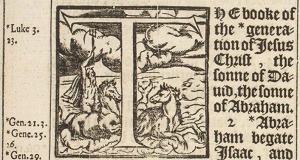Matthew 27:60
From Textus Receptus
(Textus Receptus, Theodore Beza, 1598)
Matthew 27:60 And laid it in his own new tomb, which he had hewn out in the rock: and he rolled a great stone to the door of the sepulchre, and departed
(King James Version, Pure Cambridge Edition)
Contents |
Interlinear
Commentary
Greek
Textus Receptus
Desiderius Erasmus
- 1516 (Erasmus 1st Novum Instrumentum omne)
- 1519 (Erasmus 2nd)
- 1522 (Erasmus 3rd Novum Testamentum omne)
- 1527 (Erasmus 4th)
- 1535 (Erasmus 5th)
Colinæus
- 1534 (Colinæus)
Stephanus (Robert Estienne)
- 1546 (Robert Estienne (Stephanus) 1st)
- 1549 (Robert Estienne (Stephanus) 2nd)
- 1550 (Robert Estienne (Stephanus) 3rd - Editio Regia)
- 1551 (Robert Estienne (Stephanus) 4th)
Theodore Beza
- 1565 (Beza 1st)
- 1565 (Beza Octavo 1st)
- 1567 (Beza Octavo 2nd)
- 1580 (Beza Octavo 3rd)
- 1582 (Beza 2nd)
- 1589 (Beza 3rd)
- 1590 (Beza Octavo 4th)
- 1598 (Beza 4th)
See Also Matthew 1:1 Beza 1598 (Beza)
- 1604 (Beza Octavo 5th)
Elzevir
Scholz
Scrivener
- 1894 (? ????? ???T???)
Other Greek
- 1857 (Tregelles' Greek New Testament)
- (Tischendorf 8th Ed.)
- 1881 (Westcott & Hort)
- (Greek orthodox Church)
Anglo Saxon Translations
- 1000 (Anglo-Saxon Gospels Manuscript 140, Corpus Christi College by Aelfric)
- 1200 (Anglo-Saxon Gospels Hatton Manuscript 38, Bodleian Library by unknown author)
English Translations
- 1535 (Coverdale Bible)
- 1539 (Great Bible First Edition - Miles Coverdale)
- 1540 (Great Bible Second Edition - Miles Coverdale)
- 1560 (Geneva Bible) First Edition
- 1568 (Bishop's Bible First Edition
- 1745 (Mr. Whiston's Primitive New Testament)
- 1770 (Worsley Version by John Worsley)
- 1790 (Wesley Version by John Wesley)
- 1795 (A Translation of the New Testament from the Original Greek by Thomas Haweis)
- 1833 (Webster Version - by Noah Webster)
- 1835 (Living Oracles by Alexander Campbell)
- 1850 (King James Version by Committee)
- 1851 (Murdock Translation)
- 1858 (The New Testament Translated from the Original Greek by Leicester Sawyer)
- 1865 (The New Testament of Our Lord and Savior Jesus Christ 1865 by American Bible Union)
- 1869 (Noyes Translation by George Noyes)
- 1885 (Revised Version also called English Revised Version - Charles Ellicott editor)
- 1890 (Darby Version 1890 by John Darby)
- 1901 The book of the generation of Jesus Christ, the son of David, the son of Abraham. (American Standard Version - Philip Schaff)
- 1902 The Lineage Roll of Jesus Christ,––Son of David, Son of Abraham. (The Emphasised Bible Rotherham Version)
- 1902 (Translation of the New Testament from the Original Greek by William Godbey)
- 1904 (The New Testament: Revised and Translated by Adolphus Worrell)
- 1904 (Twentieth Century New Testament by Ernest Malan and Mary Higgs)
- 1911 (Syrus Scofield)
- 1912 (Weymouth New Testament)
- 1918 (The New Testament Translated from the Sinaitic Manuscript by Henry Anderson)
- 1923 (Edgar Goodspeed)
- 1995 (New American Standard Bible) (©1995)
- (BBE)
- (Holman Christian Standard Bible)
- (21st Century King James Version)
- (Common English Bible)
- (GOD’S WORD Translation)
- (Contemporary English Version)
- (New Living Translation)
- (Amplified Bible)
- (The Message)
- (New International Reader's Version)
- (Wycliffe New Testament)
Foreign Language Versions
Arabic
- (Arabic Smith & Van Dyke)
Aramaic
- (Aramaic Peshitta)
Basque
Bulgarian
- 1940 (Bulgarian Bible)
Chinese
- 1 (Chinese Union Version (Simplified))
- 1 (Chinese Union Version (Traditional))
French
- (French Darby)
- 1744 (Martin 1744)
- 1744 (Ostervald 1744)
German
- 1545 (Luther 1545)
- 1871 (Elberfelder 1871)
- 1912 (Luther 1912)
Italian
- 1649 E lo pose nel suo monumento nuovo, il quale egli avea fatto tagliar nella roccia; ed avendo rotolato una gran pietra in su l’apertura del monumento, se ne andò. (Giovanni Diodati Bible 1649)
- 1927 e lo pose nella propria tomba nuova, che aveva fatta scavare nella roccia, e dopo aver rotolata una gran pietra contro l’apertura del sepolcro, se ne andò. (Riveduta Bible 1927)
Japanese
Latin
- 1527 (Erasmus 1527)
- 1527 (Erasmus Vulgate 1527)
Pidgin
- 1996 (Pidgin King Jems)
Romainian
- 2010 (Biblia Traducerea Fidela în limba româna)
Russian
Phonetically:
Spanish
- (RVG Spanish)
Swedish
- 1917 och lade den i den nya grav som han hade låtit hugga ut åt sig i klippan; och sedan han hade vältrat en stor sten för ingången till graven, gick han därifrån. (Swedish - Svenska 1917)
Tagalog
- 1905 At inilagay sa kaniyang sariling bagong libingan, na kaniyang hinukay sa bato: at iginulong niya ang isang malaking bato sa pintuan ng libingan, at umalis. (Ang Dating Biblia 1905)
Tok Pisin
- 1996 (Tok Pisin King Jems)
Vietnamese
- 1934 và đưa để trong một cái huyệt mới mà người đã khiến đục cho mình trong hòn đá; đoạn, lăn một hòn đá lớn đến trước cửa mồ, rồi đi. (VIET)

